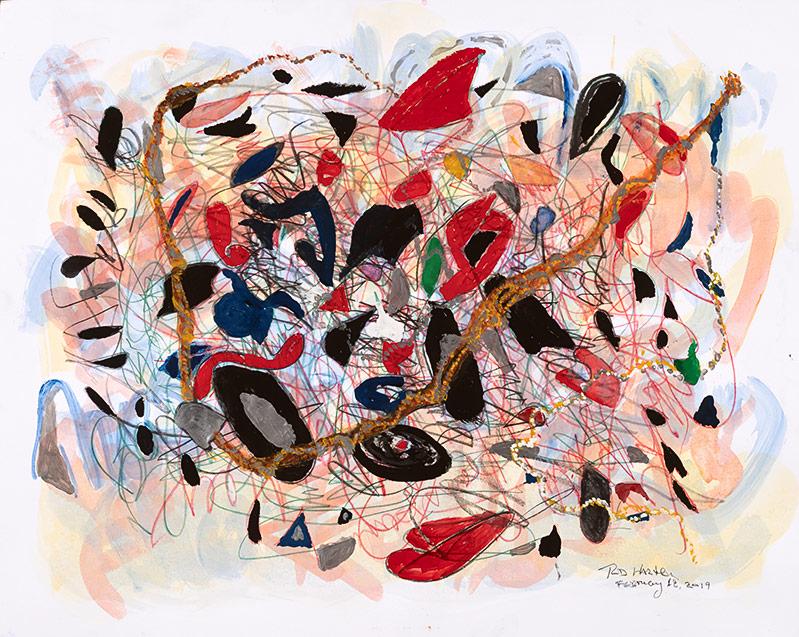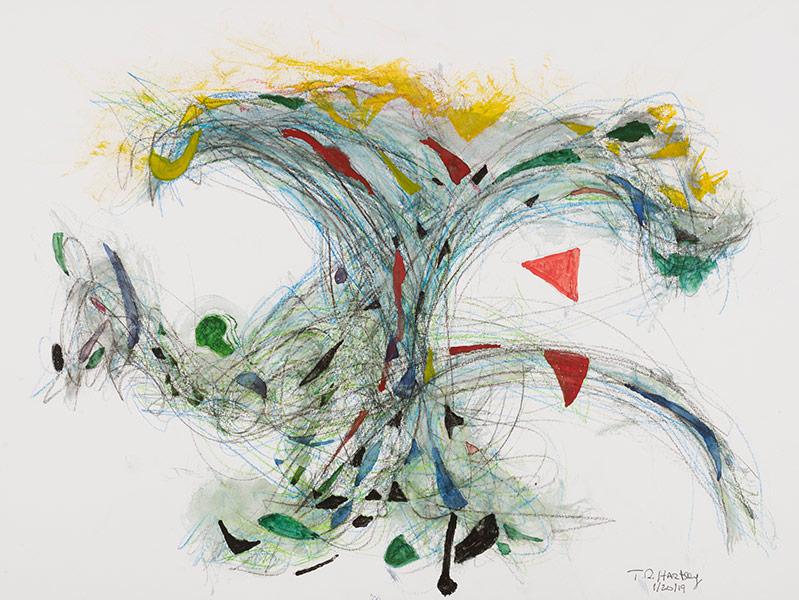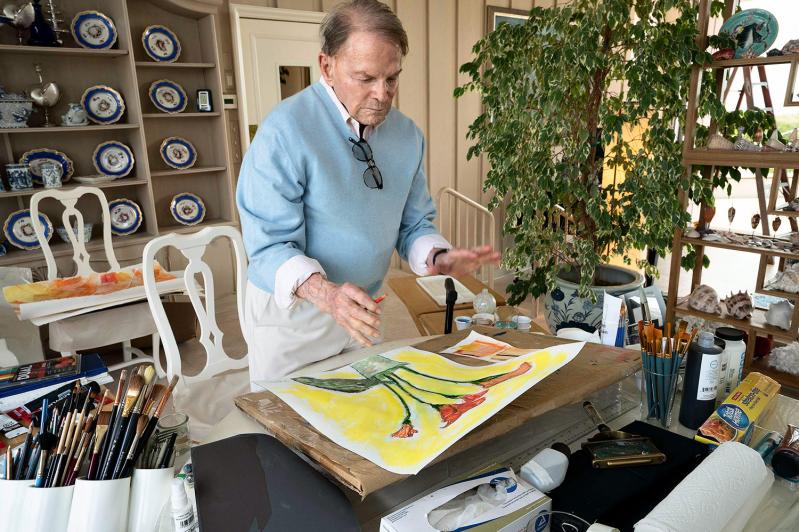Ted Hartley has lived such a full life — Navy pilot, actor, investment banker, writer, producer, movie studio head, and with his late wife, Dina Merrill, philanthropist — that he could be excused for spending his days on the deck of his oceanfront house listening to the waves roll in.
In response to an observation that he has had success at so many different careers, he said, “I don’t have any understanding of success. I wouldn’t know it if I ran into it on the street.” He is thoughtful, articulate, self-effacing, and, remarkably, he has embarked on yet another career. As he put it, “I am a seeker, and what I’m seeking I always go after in whatever way I can.”
What he has been seeking in recent years is self-expression through visual art, although that quest, as he describes it, has been a two-way street. “I decided at a certain point that art had chosen me and I couldn’t resist it. It’s like the wand for Harry Potter: The wand chooses Harry, he doesn’t choose the wand.”
While he admits that he drew cartoons during meetings throughout his life, it wasn’t until 10 years ago, when his wife first became ill, that he took up pencils and brushes. “As Dina was beginning to need more help and looking for something that would interest her and keep her moving and keep her friends coming around, we started these art classes both here in East Hampton and when we would travel.”

The classes were an opportunity to see people Ms. Merrill liked without having to entertain. “It was a wonderful thing for her,” Mr. Hartley said. “We would get together once and sometimes twice a week.” Their relationships with friends who joined the classes reached “a depth that we would never have reached just in casual conversation or over a martini.”
Whether in East Hampton or their residence in Palm Beach, the dining room table served as the studio. “On Saturday or Sunday morning, it wasn’t a place you ate, it was a place you created, and people came in and joined us. It was terrific, but the wand had not yet chosen me.” Mr. Hartley admitted that at first he didn’t care much for contemporary or even some modern art.
Following Ms. Merrill’s death in May 2017, Mr. Hartley had to relearn how to be single after 29 years of marriage. One day a friend asked if he planned to continue with the art classes. “Suddenly, out of nowhere, in about three weeks, it blossomed again, and it’s still going on, run by Corinne Strauss. When I interviewed her, she said, ‘I don’t really teach art. I help people find their voice.’ ”
In the year since, Mr. Hartley discovered that the idea of finding his visual “voice” was a new way of looking at making art. “It wasn’t creating something to see if it matched up to something else. It was, ‘What story do I want to tell?’ I think of myself as a storyteller. Suddenly, like a rose in bud, stuff began to happen, and I have never looked back. It still moves me in ways I don’t control.”
One of the things that happened was a solo exhibition of his paintings at the Keyes Gallery in Sag Harbor in September. “I was riding a bicycle with my hands off the handles, and suddenly that was a new kind of flying. When you get those moments, you’re just there, you’re immersed, and it’s wonderful.”
He knows about flying. When he was 14, he won an essay contest sponsored by Warner Brothers. His 50-word composition, “Why I Would Like to Fly,” earned him flying lessons. He attended the Shattuck Military Academy in Minnesota, then was appointed to the United States Naval Academy. After being commissioned as an officer, he served as a carrier-based pilot.
“I found flight training fulfilling in many ways. It was as close as one could come in the military to being in the zone. And then, in 1964, in spite of all my possible self-aggrandizing dreams of doing something great and getting medals, I fell getting out of a fighter plane and broke my back on the deck. What an ignominious way to go! It’s not the way I planned it.”
He went on to Harvard Business School and became vice president of First Western Financial Corporation. At the same time, in 1965 he began an almost 50-year acting career with a recurring role as the Rev. Jerry Bedford in the television series “Peyton Place.”

“I was self-conscious as an actor, but fortunately I was given parts where self-consciousness was part of the role, and I got away with it. I wanted to be a member at the Actors Studio, and I just didn’t quite get there. Even though Lee Strasberg said wonderful things about me occasionally, I always had that feeling that he wanted me to be a little more authentic.”
“I remember when I was first in ‘Peyton Place,’ and it embarrasses me to say it, but I went to my agent and said, ‘Okay, so I’ve been on this television series for six months, when do I get to be a movie star?’ And he said, ‘You’re a regular on “Peyton Place,” this is something actors give their life for, and you need to do that. Be happy on “Peyton Place,” be the best minister “Peyton Place” could ever imagine.’ ”
His 40 film credits as an actor include “Barefoot in the Park” (1967), “High Plains Drifter” (1973), “Caddyshack” (1980), and, most recently, “A Late Quartet” (2012). In addition, he has been producer or executive producer on 15 films since 1990.
In 1991, while a partner in Pavilion Communications, he merged that company with RKO Pictures and recapitalized and restructured it. Because RKO owns the stage rights to the library of classic RKO films, Mr. Hartley has also produced a number of theatrical productions, including the 2008 Broadway revival of “Gypsy” and the 2012 London production of “Top Hat.”
His many other achievements seem less important to him than his recent development as an artist, and the Keyes show was a milestone. While at the opening, he overheard a woman say his work was authentic. “I thought, that’s what I want to be, that’s where the grail is, where the floss is, authenticity is the thing to keep moving toward.”
Mr. Hartley showed more than 20 abstract works on paper in the exhibition, executed in ink, pastel, charcoal, colored pencil, watercolor, acrylic, and oil pastel. In an essay for the exhibition catalog, George Negroponte, an artist and curator, placed Mr. Hartley in the artistic tradition of such painters as William Merritt Chase, Fairfield Porter, Jackson Pollock, Lee Krasner, and Willem de Kooning.
“Ted Hartley has that uncanny ability to make art that is drenched in living atmosphere, color, and light,” wrote Mr. Negroponte. “His images palpitate like whipped up airborne particles of energy that create an infinite and indeterminate mist. . . . Hartley believes the sea and sky can be captured in a bottle . . . .”
The conversation with Mr. Hartley took place at one end of his dining room table; his painting materials occupied the other. “It’s okay,” he said, “but it’s somehow like mixing metaphors.” He is in the process of converting a former breezeway into a studio. “To have a dedicated space where I can paint is going to make a lot of difference.”




